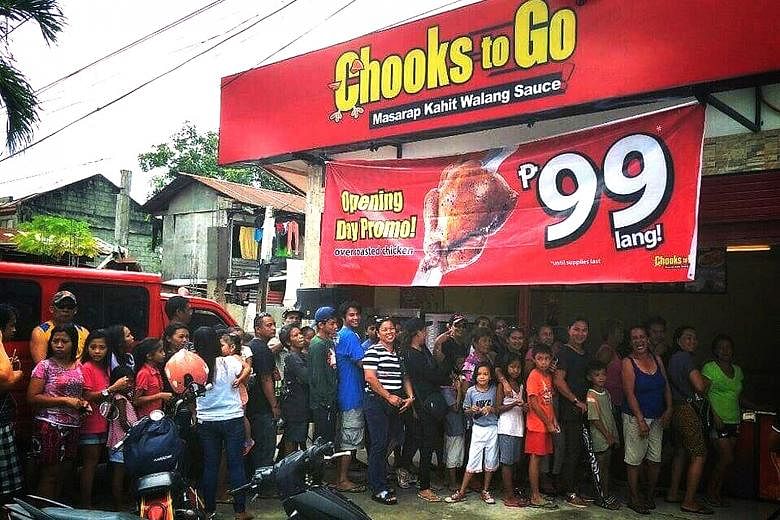When people are happy, they tend to go out more to enjoy themselves.
Just ask Chooks To Go. The Philippines' largest rotisserie chicken chain has over 1,500 kiosks scattered across the archipelago of 100 million people. Like most food companies here, it barely winces amid downturns and weathered the bird flu worries earlier this year.
Today, the strong economy is helping its push to expand its other brands, including two more roasteries, Uling Roasters, which uses flavours created for a planned African foray, and Reyal, which has less conventional flavours made from honey, chilli pepper and garlic.
"Filipinos always love good food," Mr Mel Orencia, brand development manager at Chooks To Go, told The Straits Times. "In fact, their appetite for the coming holiday will be more intense, so we expect record-breaking revenues this December."
Economists say consumer demand is still the main growth driver. Money from millions of Filipinos abroad and a still-burgeoning outsourcing industry continues to pour in. There was also a bump in exports in the third quarter.
That money, in turn, is being spent on items from luxury items to essentials like clothing and food.
"We are in a favourable environment. I believe (growth) is doing us a lot of favour," Mr Orencia said.
Gross domestic product clocked year-on-year growth of 6.9 per cent in the third quarter, beating analysts' expectations of 6.6 per cent.
That made the Philippines the second-fastest-growing economy in Asia, behind only Vietnam, which recorded 7.5 per cent in the third quarter, and outpacing China's 6.8 per cent.
Said Economic Planning Secretary Ernesto Pernia: "With a year-to-date growth average at 6.7 per cent, we are optimistic that we are on track in meeting the full-year target range of 6.5 per cent to 7.5 per cent GDP growth for 2017."
Mr Pernia said he expects the coming years to be as robust, as the government begins rolling out projects lined up under President Rodrigo Duterte's ambitious eight-trillion-peso "Build, Build, Build" infrastructure programme.
Still, his predecessor Cielito Habito advised caution, saying that while third-quarter consumer spending remained healthy, growth in private consumer spending, which accounts for 40 per cent of total spending, had eased from 7.5 per cent last year to 5.6 per cent this year, probably due to rising prices.
Government expenditure also slowed from 9.6 per cent to 5.3 per cent. "It was actually exports that saved the day, with a doubling in its growth from 9.9 per cent to 19.2 per cent," said Mr Habito.
"What does it all mean? Achieving our desired growth path will entail getting households, government and business firms to spend more, and faster. That means making good on 'Build, Build, Build' and ensuring a better investment climate, among other things," he said.

